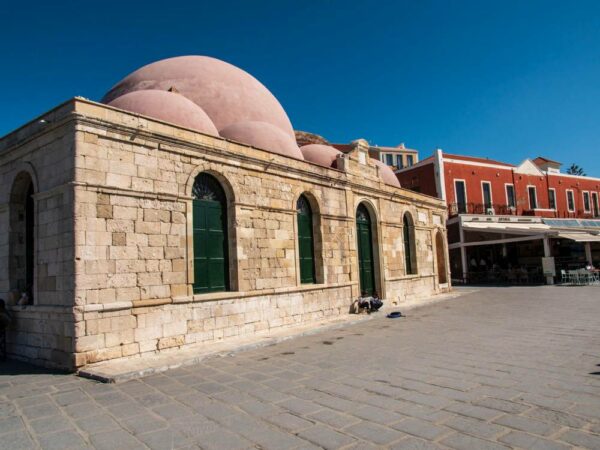-
 Küçük Hasan Pasha Mosque (Yalı Mosque) Square
Küçük Hasan Pasha Mosque (Yalı Mosque) Square - Operator: MUNICIPAL PORT FUND OF CHANIA
- Address: Chania Old Venetian Harbour (View Location on Google Maps)
- Space dimension: 250 sq.m.
- Capacity: 60 persons
- Phone: +302821341747
- Email: info@dlx.gr
It is the only Mosque built by the Turks in the city of Chania during the second half of the 17th century. It was built in honour of Küçük Hasan, first castellan (garrison commander) of Chania. It became known as Yalı Mosque (Waterfront mosque) or Hamal Mosque (the mosque of the heavers) because it was located at an area where ships used to load and unload their cargo.
While restoration works were being performed, the Ephorate of Antiquities conducted a research which revealed that the mosque occupied the site of a pre-existing small single-aisled temple. The mosque is a cube-shaped building which is crowned by a large hemispherical dome with no drum, supported by four elaborate stone arches. Its western and northern sides are delimited by a dome-topped covered arcade with six small domes with no drum. Initially the arcade was not covered, as is the case in most mosques. Around 1880 it was covered and featured arched openings and a highly neoclassical style. In the southwest corner was the minaret of which only the base has survived to this day. To the south there was a small cemetery with trees and right across the large building of the Imaret (Ottoman poorhouse) is still standing. Around 1880 the middle arch was converted into a door. Around 1893, the small cove was filled with rubble, a platform was built to the west and the three façades acquired a more neoclassical style with arched openings and a fountain. The Customs House and the building of the Bank of Athens were constructed on the newly-created surface.
Küçük (small) Hasan Pasha Mosque or Yali Jamisι (Waterfront Mosque) was the work of an Armenian architect, who had built another similar mosque in the village of Spaniako of Selino. The mosque operated until 1923. It was subsequently restored but its minaret was demolished in 1920 (or 1939). It used to house the Archaeological Museum of Chania. In 1964, after the demolition of the south side and of the two buildings on the square at the back, the modern Port Authority Pavilion was added which was later demolished to make space for the monument. It was also used as a warehouse, a Folk Art Museum, and an Information Office of the Greek National Tourism Organisation (GNTO). At present, it operates as an exhibition space which hosts temporary exhibitions and cultural events.
Michalis Andrianakis – Archaeologist
